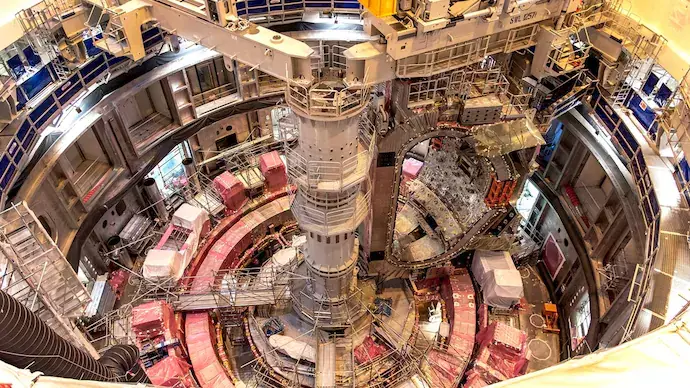
Global Nuclear Fusion Project Crosses Milestone with World’s Most Powerful Magnet
The quest for clean and sustainable energy has taken a significant step forward with the completion of the central solenoid, the final component of the International Thermonuclear Experimental Reactor (ITER) project. This monumental achievement marks a major milestone in the global nuclear fusion endeavor, which aims to generate energy by smashing atoms together at super-high temperatures.
The ITER project involves more than 30 countries and is considered the most ambitious nuclear fusion project in the world. The endeavor is a collaborative effort between nations to develop a new source of clean energy, which could potentially replace fossil fuels and mitigate climate change.
The central solenoid, a crucial component of the ITER reactor, has been completed and tested by the United States. This massive magnet is the world’s most powerful, with a weight of over 4,000 tons and a length of 19 meters. Its primary function is to generate a magnetic field that will confine and heat the plasma, a hot, ionized gas, to incredibly high temperatures, reaching as high as 150 million degrees Celsius.
The ITER reactor is designed to achieve a breakthrough in nuclear fusion, a process that mimics the sun’s energy production. By fusing two isotopes of hydrogen, deuterium and tritium, the reactor will produce a massive amount of energy. This energy will be generated through the release of helium nuclei, which will be trapped in a magnetic field, creating a self-sustaining reaction.
The ITER project has been in development for over three decades, with numerous challenges and setbacks along the way. However, the completion of the central solenoid marks a significant achievement, demonstrating the project’s progress and the team’s dedication to realizing the vision of nuclear fusion.
The construction of the ITER reactor is a massive undertaking, requiring the collaboration of thousands of engineers, scientists, and technicians from around the world. The project’s headquarters are located in Cadarache, France, where the reactor will be assembled. The site is a vast complex, covering an area of over 180 hectares, with several buildings and infrastructure in place to support the construction and operation of the reactor.
The ITER project is expected to produce a massive amount of energy, equivalent to the electricity generated by a small nuclear power plant. While it may not be enough to replace fossil fuels immediately, the project’s success could pave the way for the development of commercial nuclear fusion power plants in the future.
The potential benefits of nuclear fusion are numerous. It is a zero-carbon source of energy, producing no greenhouse gas emissions or long-lived radioactive waste. The process is also inherently safe, as it relies on a self-sustaining reaction that cannot be triggered by accident.
The completion of the central solenoid marks a significant milestone in the ITER project, but there is still much work to be done. The reactor’s construction is expected to take several years, with the first plasma being generated in the early 2020s. The project’s scientists and engineers will then begin to fine-tune the reactor, testing and optimizing its performance.
The ITER project is a testament to international cooperation and the pursuit of a cleaner, more sustainable future. As the world continues to grapple with the challenges of climate change and energy security, the development of nuclear fusion offers a promising solution. With the completion of the world’s most powerful magnet, the ITER project has taken a significant step forward, bringing humanity closer to harnessing the limitless energy of the sun.






